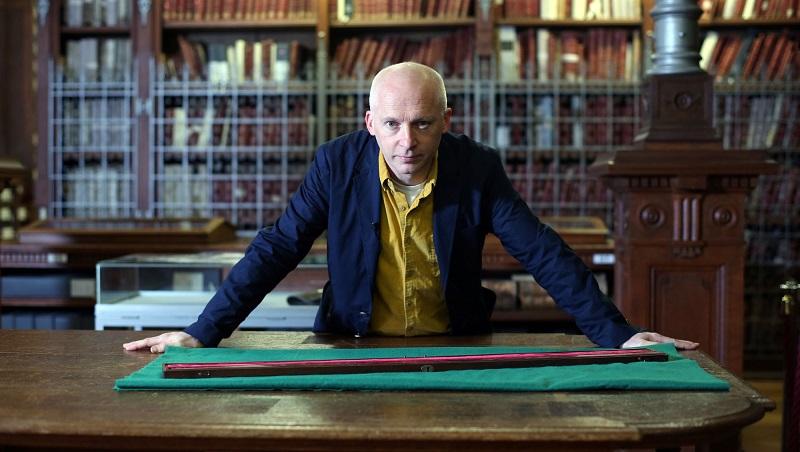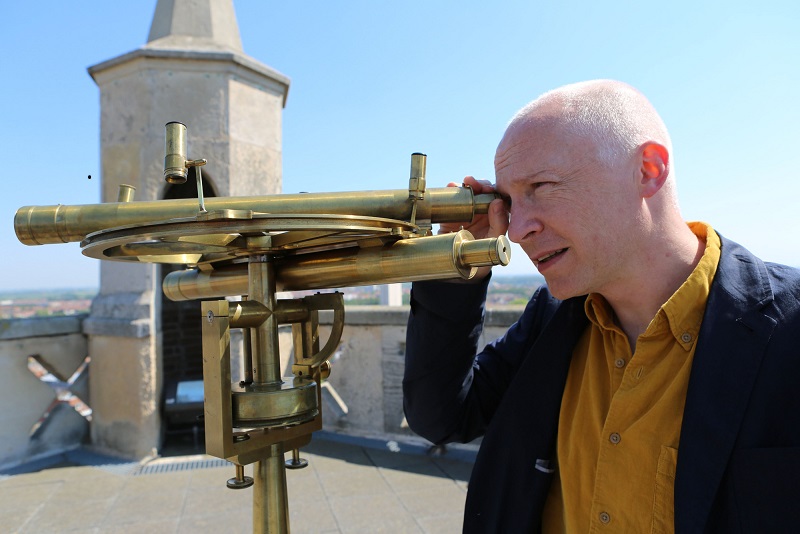Precision: The Measure of All Things, BBC Four | reviews, news & interviews
Precision: The Measure of All Things, BBC Four
Precision: The Measure of All Things, BBC Four
A brisk jaunt through the abstracts with the Grand Elucidator of Science

Given the breadth of Marcus du Sautoy’s cultural scholarship, it was a small surprise that British poet Andrew Marvell wasn't name-checked at the start of the presenter’s new three-parter Precision: The Measure of All Things. “Had we but world enough and time,” the great Metaphysical wooer called to his Coy Mistress, touching directly on the subjects of episode one, “Time and Distance”.
With landmarks like The Story of Maths behind him, du Sautoy is now a bit of a screen natural, making the appeal of measuring things with ever-increasing degrees of accuracy seem real, even infectious. Whether we will really have found our own human order when we’ve quantified the last unknown out there, and bested the extremes of precision, may be a subject for psychologists, but in this attempt, with du Sautoy as our guide, it sure was thrilling.
There’s a beguiling element of competition, as du Sautoy predicts part two's battle in which 'the best minds in measurement science fight it out'
It proved a cultural journey as much as anything else: from the Lascaux caves, where stars and stags set the weeks and the seasons, to the Pyramids, which wouldn’t have happened without the cubit (local administrators faced the death penalty, apparently, if they didn’t annually recalibrate against the Pharaoh’s cubit). Monty Python territory loomed occasionally close, though du Sautoy resisted any hint of a snigger, as we learnt that the 12th-century British yard was the length from the King’s nose to the end of his outstretched thumb.
Things weren’t any clearer across the Channel, when pre-revolutionary France had apparently more than a quarter of a million different weights and measures (the sheer vocabulary of it all!). If rivalry across la Manche was an ongoing issue – Greenwich trumped in the dateline stakes – France won for the sheer bloody-mindedness with which they set the metre (main picture). Two valiant Gallic triangulators set out from Dunkirk and Barcelona in 1791 hoping to meet somewhere in the middle: they duly did, seven years later, their journeys complicated not least by the uncertain atmosphere of the aftermath of the Revolution (pictured right, getting to grips with a triangulating telescope).
 Ahead of us are “Mass and Moles”, the latter referring to the shyest of the seven units of measurement, before it all concludes with “Light, Heat and Electricity”. There’s a beguiling element of competition set up, as du Sautoy predicts part two's battle in which “the best minds in measurement science fight it out”, and there can only be one winner. One of their foes comes right out of the wrestling ring, too – that’s “Le Grand K”, once the world’s master kilogramme, but now, it seems, shedding weight alarmingly.
Ahead of us are “Mass and Moles”, the latter referring to the shyest of the seven units of measurement, before it all concludes with “Light, Heat and Electricity”. There’s a beguiling element of competition set up, as du Sautoy predicts part two's battle in which “the best minds in measurement science fight it out”, and there can only be one winner. One of their foes comes right out of the wrestling ring, too – that’s “Le Grand K”, once the world’s master kilogramme, but now, it seems, shedding weight alarmingly.
By the end registering each new advancement started to leave me breathless, as one possible climax followed another with more frequency even than in Isolde’s Liebestod. It made you wonder if there was another side to be found in this battle with precision, a sort of Slow Food movement of measurement. If there is, and it has an unofficial headquarters, it must be in the Cairo taxi where du Sautoy admitted to being flummoxed by a speedometer reading both miles and kilometres. Cairo traffic being as special as it is, he was prompted to a truly jaw-dropping admission – that he’d never understood the first thing about how shoe sizes are measured. The germ of something there, surely? BBC Four, take note.
Add comment
The future of Arts Journalism
You can stop theartsdesk.com closing!
We urgently need financing to survive. Our fundraising drive has thus far raised £49,000 but we need to reach £100,000 or we will be forced to close. Please contribute here: https://gofund.me/c3f6033d
And if you can forward this information to anyone who might assist, we’d be grateful.

Subscribe to theartsdesk.com
Thank you for continuing to read our work on theartsdesk.com. For unlimited access to every article in its entirety, including our archive of more than 15,000 pieces, we're asking for £5 per month or £40 per year. We feel it's a very good deal, and hope you do too.
To take a subscription now simply click here.
And if you're looking for that extra gift for a friend or family member, why not treat them to a theartsdesk.com gift subscription?
more TV
 The Waterfront, Netflix review - fish, drugs and rock'n'roll
Kevin Williamson's Carolinas crime saga makes addictive viewing
The Waterfront, Netflix review - fish, drugs and rock'n'roll
Kevin Williamson's Carolinas crime saga makes addictive viewing
 theartsdesk Q&A: writer and actor Mark Gatiss on 'Bookish'
The multi-talented performer ponders storytelling, crime and retiring to run a bookshop
theartsdesk Q&A: writer and actor Mark Gatiss on 'Bookish'
The multi-talented performer ponders storytelling, crime and retiring to run a bookshop
 Ballard, Prime Video review - there's something rotten in the LAPD
Persuasive dramatisation of Michael Connelly's female detective
Ballard, Prime Video review - there's something rotten in the LAPD
Persuasive dramatisation of Michael Connelly's female detective
 Bookish, U&Alibi review - sleuthing and skulduggery in a bomb-battered London
Mark Gatiss's crime drama mixes period atmosphere with crafty clues
Bookish, U&Alibi review - sleuthing and skulduggery in a bomb-battered London
Mark Gatiss's crime drama mixes period atmosphere with crafty clues
 Too Much, Netflix - a romcom that's oversexed, and over here
Lena Dunham's new series presents an England it's often hard to recognise
Too Much, Netflix - a romcom that's oversexed, and over here
Lena Dunham's new series presents an England it's often hard to recognise
 Insomnia, Channel 5 review - a chronicle of deaths foretold
Sarah Pinborough's psychological thriller is cluttered but compelling
Insomnia, Channel 5 review - a chronicle of deaths foretold
Sarah Pinborough's psychological thriller is cluttered but compelling
 Live Aid at 40: When Rock'n'Roll Took on the World, BBC Two review - how Bob Geldof led pop's battle against Ethiopian famine
When wackily-dressed pop stars banded together to give a little help to the helpless
Live Aid at 40: When Rock'n'Roll Took on the World, BBC Two review - how Bob Geldof led pop's battle against Ethiopian famine
When wackily-dressed pop stars banded together to give a little help to the helpless
 Hill, Sky Documentaries review - how Damon Hill battled his demons
Alex Holmes's film is both documentary and psychological portrait
Hill, Sky Documentaries review - how Damon Hill battled his demons
Alex Holmes's film is both documentary and psychological portrait
 Outrageous, U&Drama review - skilfully-executed depiction of the notorious Mitford sisters
A crack cast, clever script and smart direction serve this story well
Outrageous, U&Drama review - skilfully-executed depiction of the notorious Mitford sisters
A crack cast, clever script and smart direction serve this story well
 Prost, BBC 4 review - life and times of the driver they called 'The Professor'
Alain Prost liked being world champion so much he did it four times
Prost, BBC 4 review - life and times of the driver they called 'The Professor'
Alain Prost liked being world champion so much he did it four times
 The Buccaneers, Apple TV+, Season 2 review - American adventuresses run riot in Cornwall
Second helping of frothy Edith Wharton adaptation
The Buccaneers, Apple TV+, Season 2 review - American adventuresses run riot in Cornwall
Second helping of frothy Edith Wharton adaptation
 The Gold, Series 2, BBC One review - back on the trail of the Brink's-Mat bandits
Following the money to the Isle of Man, Spain and the Caribbean
The Gold, Series 2, BBC One review - back on the trail of the Brink's-Mat bandits
Following the money to the Isle of Man, Spain and the Caribbean

Comments
I'm a maths and physics geek,
Given the programme is about
A DISTINCT LACK OF
I agree the the professor
Also in the final episode